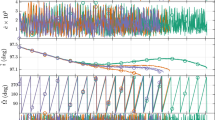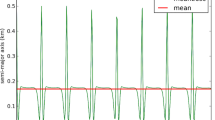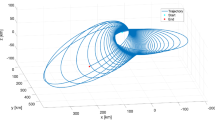Abstract
The long-term evolution characteristics and stability of an orbit are well characterized using a mean element propagation of the perturbed two body variational equations of motion. The averaging process eliminates short period terms leaving only secular and long period effects. In this study, a non-traditional approach is taken that averages the variational equations using adaptive numerical techniques and then numerically integrating the resulting equations of motion. Doing this avoids the Fourier series expansions and truncations required by the traditional analytic methods. The resultant numerical techniques can be easily adapted to propagations at most solar system bodies.





Similar content being viewed by others
Notes
The m-simplex capability of CUBPACK is not needed for this application.
The initial mean elements were obtained from the initial osculating elements using a first-order near-identity transformation that was derived using the methods described in the companion paper ‘Transforming Mean and Osculating Elements using Numerical Methods,’ written by the author.
The initial mean elements were obtained from the initial osculating elements using a first-order near-identity trans-formation that was derived using the methods described in the companion paper ‘Transforming Mean and Osculating Elements using Numerical Methods,’ also written by the author.
References
Ely, T.A., Howell, K.C.: Long-term evolution of artificial satellite orbits due to resonant tesseral harmonics. J. Astronaut. Sci. 44(2), 167–190 (1996)
Ely, T.A., Howell, K.C.: Dynamics of artificial satellite orbits with tesseral resonances including the effects of luni- solar perturbations. Dyn. Stab. Syst. 12 (4), 243–269 (1997)
Cefola, P., Long, A.C., Holloway Jr., G.: The Long-Term Prediction of Artificial Satellite Orbits. In: AIAA 12th Aerospace Sciences Meeting, p 33 (1974)
Cefola, P., McClain, W., Early, L., Green, A.: A semianalytical satellite theory for weak time-dependent perturbations. In: NASA Goddard Space Flight Center Flight Mechanics/Estimation Theory Symposium, pp 67–91 (1980)
McClain, W.D.: A recursively formulated first-order semianalytic artificial satellite theory based on the generalized method of averaging, Vol. 1. Computer Sciences Corporation (1977)
McClain, W.D.: A recursively formulated first-order semianalytic artificial satellite theory based on the generalized method of averaging, Vol. 2. Computer Sciences Corporation (1978)
McClain, W.D., Long, A.C., Early, L.W.: Development and evaluation of a hybrid averaged orbit generator. In: AIAA/AAS Astrodynamics Conference (1978)
Kwok, J.H.: Long-term orbit prediction for the Venus Radar Mapper Mission using an averaging method. In: AIAA/AAS Astrodynamics Conference (1984)
Kwok, J.H.: The implementation of two satellite programs in a microcomputer environment. In: AIAA/AAS Astrodynamics Conference (1986)
Uphoff, C.: Numerical averaging in orbit prediction. AIAA J. 11(11), 1512–1516 (1973)
Lutzky, D., Uphoff, C.: Short-Periodic Variations and Second-Order Numerical Averaging. In: AIAA 13th Aerospace Sciences Meeting (1975)
Genz, A., Cools, R.: An adaptive numerical cubature algorithm for simplices. ACM Trans. Math. Softw. 29(3), 297–308 (2003)
Cools, R., Haegemans, A.: Algorithm 824: CUBPACK: a package for automatic cubature; framework description. ACM Trans. Math. Softw. 29(3), 287–296 (2003)
Sanders, J., Verhulst, F., Murdock, J.: Averaging Methods in Nonlinear Dynamical Systems, 2nd ed., no. 59. Springer (2007)
Smyth, G.K.: Numerical Integration, Encyclopedia of Biostatistics, pp 3088–3095 (1998)
Flanagen, S., Ely, T.A.: Navigation and Mission Analysis Software for the Next Generation of JPL Missions. In: 16th International Symposium on Space Flight Dynamics (2001)
Krogh, F.T.: Predictor-corrector methods of high order with improved stability characteristics. J. ACM 13(3), 374–385 (1966)
Krogh, F.T.: On testing a subroutine for the numerical integration of ordinary differential equations. J. ACM 20(4), 545–562 (1973)
Krogh, F.T.: Variable Order Adams Method for Ordinary Differential Equations, 2010. Online. Available: http://mathalacarte.com/cb/mom.fcg/ya64
Sharp, P.W.: N-body simulations: the performance of some integrators. ACM Trans. Math. Softw. 32(3), 375–395 (2006)
Danielson, D.A., Neta, B., Early, L.W.: Semi-Analytic Satellite Theory (SST): Mathematical Algorithms, no. NPS-MA-94–001, p 106. Naval Postgraduate School (1994)
Konopliv, A.: Recent gravity models as a result of the lunar prospector mission. Icarus 150(1), 1–18 (2001)
Lara, M.: Design of long-lifetime lunar orbits: A hybrid approach. Acta Astronaut. 69(3–4), 186–199 (2011)
Cefola, P.: A recursive formulation for the tesseral disturbing function in equinoctial variables. In: AIAA/AAS Astrodynamics Conference (1976)
Lichtenberg, A.J., Lieberman, M.A.: Regular and Chaotic Dynamics, 2nd ed., no. 38. Springer (1992)
Gedeon, G.S.: Tesseral resonance effects on satellite orbits. Celest. Mech. 1, 167–189 (1969)
NASA: PDS Geosciences Node: Gravity Models, 2014. Online. Available: http://pds-geosciences.wustl.edu/dataserv/gravity_models.htm. Accessed: 03-Oct-2014
Konopliv, A.: Venus gravity: 180th degree and order model. Icarus 139(1), 3–18 (1999)
Giacaglia, G.E.O.: The equations of motion of an artificial satellite in nonsingular variables. Celest. Mech. 15(2), 191–215 (1977)
Folkner, W.M., Williams, J.G., Boggs, D.H.: The planetary and lunar ephemeris DE 421. Interplanet. Netw. Prog. Rep. 42(178) (2009)
Milani, A., Nobili, A.M., Farinella, P.: Non-Gravitational Perturbations and Satellite Geodesy. Adam Hilger (1987)
Izsak, I.G.: A note on perturbation theory. Astron. J. 68(8), 2 (1963)
Green, A.J.: Orbit determination and prediction processes for low altitude satellites, Massachusetts Institute of Technology (1979)
Vincent, M.A.: Explanation and History of the New Solar Cycle/Atmospheric Model Used in Mars Planetary Protection Analysis. In: Advances in the Astronautical Sciences, Vol. 109, pp 1599–1614 (2001)
Vincent, M.A., Ely, T.A., Sweetser, T.H.: Plan and Progress for Updating the Models Used for Orbiter Lifetime Analysis. In: Advances in the Astronautical Sciences, Vol. 142, pp 1835–1849 (2011)
Justus, C.G., James, B.F., Bougher, S.W., Bridger, A.F.C., Haberle, R.M., Murphy, J.R., Engel, S.: Mars-GRAM 2000: A Mars atmospheric model for engineering applications. Adv. Sp. Res. 29(2), 193–202 (2002)
Konopliv, A.S., Yoder, C.F., Standish, E.M., Yuan, D.-N., Sjogren, W.L.: A global solution for the Mars static and seasonal gravity, Mars orientation, Phobos and Deimos masses, and Mars ephemeris. Icarus 182(1), 23–50 (2006)
Acknowledgments
This work was carried out in part at the Jet Propulsion Laboratory, California Institute of Technology, under contract with the National Aeronautics and Space Administration.
Author information
Authors and Affiliations
Corresponding author
Additional information
A prior version of this paper was presented at the AAS/AIAA Astrodynamics Specialist Conference, Pittsburgh, Pennsylvannia, August 2009.
Appendix: : Direct Equinoctal Elements And Partials
Appendix: : Direct Equinoctal Elements And Partials
The direct equinoctial elements as functions of the classical elements \(\left \{ {a,e,i,{\Omega } ,\omega ,M} \right \}\) can be defined as
Some intermediate quantities are now defined. The equinoctial reference frame is composed of three orthogonal unit vectors \(\left \{ {\text {\textbf {f}},\text {\textbf {g}},\text {\textbf {w}}} \right \}\) where
-
1.
f and g are in the satellite orbit plane,
-
2.
w is along the orbit normal,
-
3.
The angle between f and the ascending node is equal to the longitude of the ascending node Ω.
Using these properties the unit vectors \(\left \{ {\text {\textbf {f}},\text {\textbf {g}},\text {\textbf {w}}} \right \}\)are obtained using
From the position r and velocity \(\dot {\textbf {r}}\) vectors the following components \(\left \{ {X,Y,\dot {{X}},\dot {{Y}}} \right \}\)can be computed
Finally the partials identified in Gauss’ (7) are
Where the following definitions apply
Rights and permissions
About this article
Cite this article
Ely, T.A. Mean Element Propagations Using Numerical Averaging. J of Astronaut Sci 61, 275–304 (2014). https://doi.org/10.1007/s40295-014-0020-2
Published:
Issue Date:
DOI: https://doi.org/10.1007/s40295-014-0020-2




